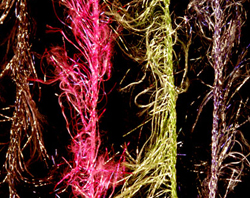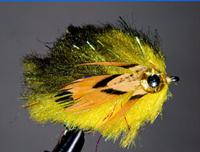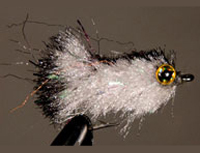Miscellaneous Materials!
Your source for flyfishing and flycraft resources since 1975.
Wax
Foam
Yarn
Vinyl Tubing
Mylar Tubing
Synthetic Tailing
Thin Skin & Latex
Hackle Flash
CCT Body Fur
Head Cement & Thinner
Wax
There's really not much to say about wax. I find that less is always better to start and don't like anything too, too tacky. Our Premium Wax in a tube will be fine.
Foam
You'll want to have some black sheets or strips to tie foam ants and beetles to start. These are relatively easy to tie and deadly to fish! You'll also want a bright color, like yellow, red or chartreuse so you can put a small piece on your ant or beetle. This will enable you to see the fly on the water much better.
Yarn
I'll start with 'Antron Yarn' because by far, it's the most popular. Used for wing cases, bodies, wings and more. We also sell a more crinkly version called Z-Yarn. I'd recommend buying a couple of colors of each. Be sure to include white, caddis green, olive, brown tan, dun and black in your choices.
Second is 'Glo-Bug Yarn.' This is the material used to tie egg patterns than many fly fisherman carry in their boxes. These are easy and quick to tie. Start with salmon, fluorescent red, fluorescent green and fluorescent pink, but eventually you'll want to try all the colors.
'Mohair Yarn' is popular for buggy nymphs and leeches. As usual, start with the basic colors of black, cream and olive. Try some as body material on your Wooly Buggers and nymph patterns.
Many of the 'other' yarns, such as Sparkle Yarn, Wool Yarn and Poly Yarn, can be used in place of the Antron Yarn mentioned above.
Vinyl Tubing
This is a "must have" material for tying realistic nymphs, including caddis nymphs on curved hooks. Using this is quick to tie and very, very effective. It's also used on stonefly nymphs, Crazy Charlies and more.
Our 'V-Rib' is flat on one side and curved on the other, like a circle cut in half. It lays nicely on the hook, ties a dynamite body and comes in two sizes: small & large. Try this in chartreuse, amber, shrimp and clear for starters. Once you start catching fish, this will become a staple on your fly tying desk.
We also have 'Larva Lace' which is completely round tubing for similar applications. The small is suitable for very tiny flies, from 12 down to size 28. The large size is for flies sizes of 4-16.
Synthetic Tailing
It's exactly that! Our Micro-Fibbets are for your smalles flies. Can also be used for wings, antennae and legs.
Thin Skin & Latex
'Thin Skin' is stretchable material with a backing which makes it easy to cut. Colors are transparent with a matte finish. Use it for tying nymph cases or nymph backs on scuds, sowbugs, crayfish and shrimp patterns. Easy to use and will tie down to size 18.
Latex sheets can be used the same as above, is more economical but has no backing. You'll want to have a package of this in cream.
Hackle Flash
Hackle Flash is considered to be synthetic hackle which can be 'palmered' or wound like a feather. This is actually Mylar yarn that has individual strands of Mylar mixed with pearl attached at a 90 degree angle. As easy as winding hackle. Think of the possibilities, streamer collars, “Mylar Speys”, Woolly Buggers, bonefish, the applications are endless. Shown at right.
CCT Body Fur
It's the material you see below. Like Hackle Flash, I consider this synthetic hackle.

You can use it for many saltwater applications like crabs and Tarpon Toads. Also use for sculpin, muddlers and bonefish flies. Trims easily and available in two sizes, 3/4" and 1 1/4." The flies below are all tied with CCT Body Fur.
 |
 |
 |
|---|
Head Cement & Thinner
Don't read too much about this. Our 'Head Cement' has been developed and refined over 30 years. Need I say more?
You'll want to have some thinner because the cement can thicken over time when exposed to air. Also, there may be some applications when you want to use a small amount that may require thinning for application.






